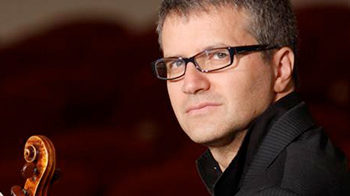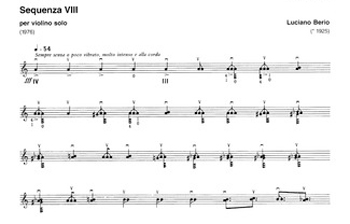by Mike Telin

Audiences will have the opportunity to hear the celebrated violinist perform Berio’s Sequenza VIII this week, when he makes his Cleveland debut on Friday, December 9 at 7:30 at Transformer Station as part of the Cleveland Museum of Art’s Performing Arts Series. The concert will feature contemporary Italian works for solo violin.
D’Orazio’s professional relationship with Berio dates back to when the violinist was studying with Carlo Chiarappa, for whom Sequenza VIII was written. “In 1987, Berio decided to publish his Divertimento for String Trio, a work that was written in 1946. He asked my teacher to play the premiere, but Carlo had no time so he asked me if I wanted to perform it. I was so happy — I was 22 and giving a premiere by Luciano Berio.”
After working on Sequenza VIII for nine months, D’Orazio called Berio and asked him if he could play the piece for him. Berio said yes, but told him that he would need to travel to the Salzburg Festival where he was composer in residence. The young violinist agreed, and although he was certain the meeting would take place in a very small room, that turned out not to be the case.
“Berio arranged for me to play in a theatre with about 50 people listening,” D’Orazio said. “He was looking at the score while I was playing, and when I finished he came on the stage and very seriously said ‘Bravo,’ then went away. I thought he didn’t like it at all, and was quite upset, so I started putting my violin in its case. Then he came back and asked me what I was doing in two days. I told him nothing, and he said that he had just spoken to the Festival director, and if I could stay, I could perform the piece at the Festival. That was 27 years ago, and I think I’ve played it at least 300 times since then. But that is only 10 to 12 performances of it each year.”

The professional relationship between the violinist and composer lasted for fifteen years. In addition to being Berio’s performer of choice for Sequenza VIII, D’Orazio was also the soloist during the final concert that Berio conducted. (Click here to view a video of Chorale su Sequenza VIII for violin, horns and strings from that performance).
Francesco D’Orazio’s repertoire includes works ranging from Baroque to classical and from romantic to contemporary music. A quick look at his discography shows the breadth of his musical undertakings. “I play everything,” he said. “I have a period instrument group that just released a new CD. I also enjoy performing Mozart and Beethoven.” The violinist has also given the Italian premieres of concertos by John Adams (The Dharma at Big Sur), Kaija Saariaho (Graal théâtre), Michael Daugherty (Fire and Blood), Aaron Jay Kernis (Lament and Prayer), and Michael Nyman (Violin Concerto No. 1).
I asked Francesco D’Orazio to talk about his program:
The Berio is a very strong work with an approach that comes from a long tradition of violin playing. It is Baroque in its structure, but it doesn’t sound like it. Sequenza VIII — along with Salvatore Sciarrino’s Capricci Nos. 1 and 4 (1975) — are probably the most important and successful works for solo violin written in the last 50 years. At first only one or two people were performing them, but now there are hundreds of violinists playing them both. What I like about Sciarrino’s music is that there is an incredible modernity, but that modernity comes from the past, so in some ways his music is also Baroque.
Luciano Chessa, “Sarabanda” and “Corrente” come from the Partita for solo violin (1987–2013). I am playing two movements, but the piece is written so I am completely free to organize it however I wish. I can play all the movements or only two. I’ll premiere the complete work in Marseilles, France in March of 2017.
Ivan Fedele’s Suite Francese II (2010), is also based on Baroque dances, and Michele Dall’Ongaro’s musical material for La Musica di E. Z. (1999) is inspired by H.P. Lovecraft’s novel The Music of Erich Zann.
Nicola Sani’s Raw (2005) is completely different from all of the others on the program. It is made up of sounds like scratching, that are found in “noise,” another aspect of contemporary music that is important to know. There is also a chance for me to improvise during the piece.
Published on ClevelandClassical.com December 5, 2016.
Click here for a printable copy of this article



